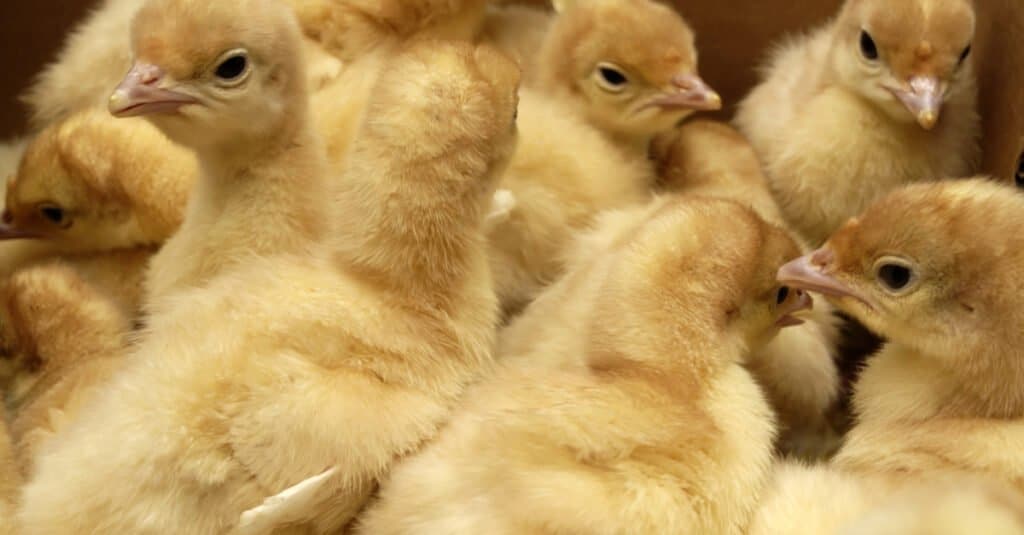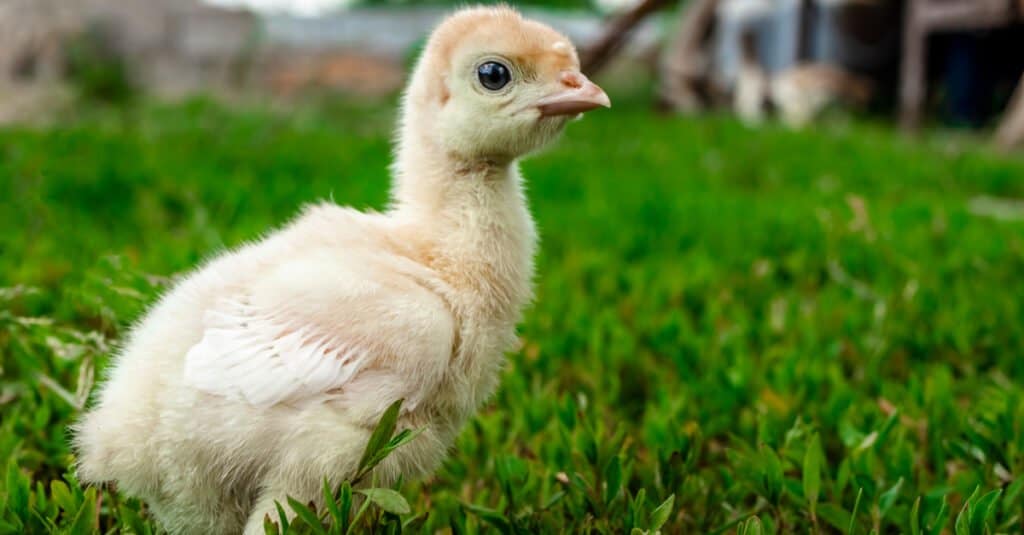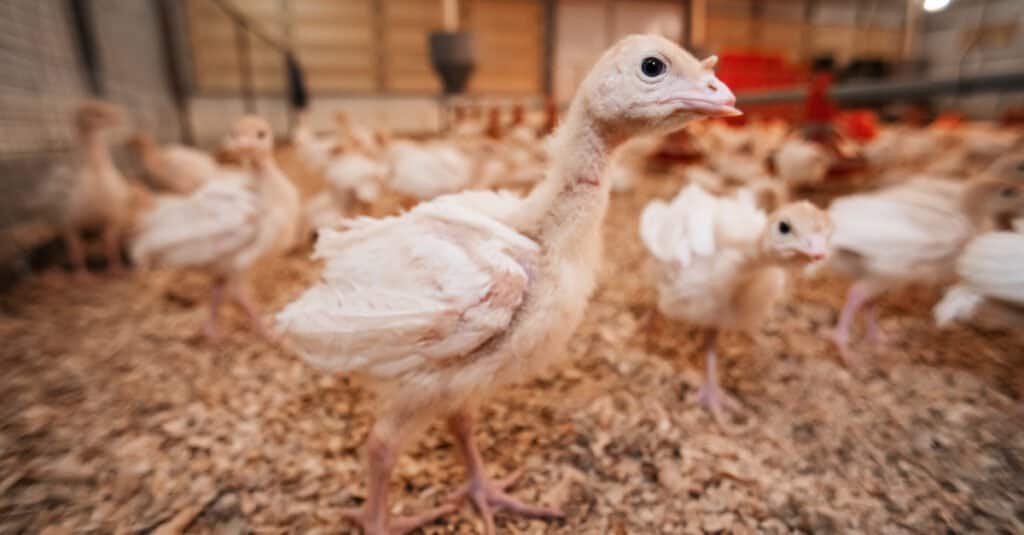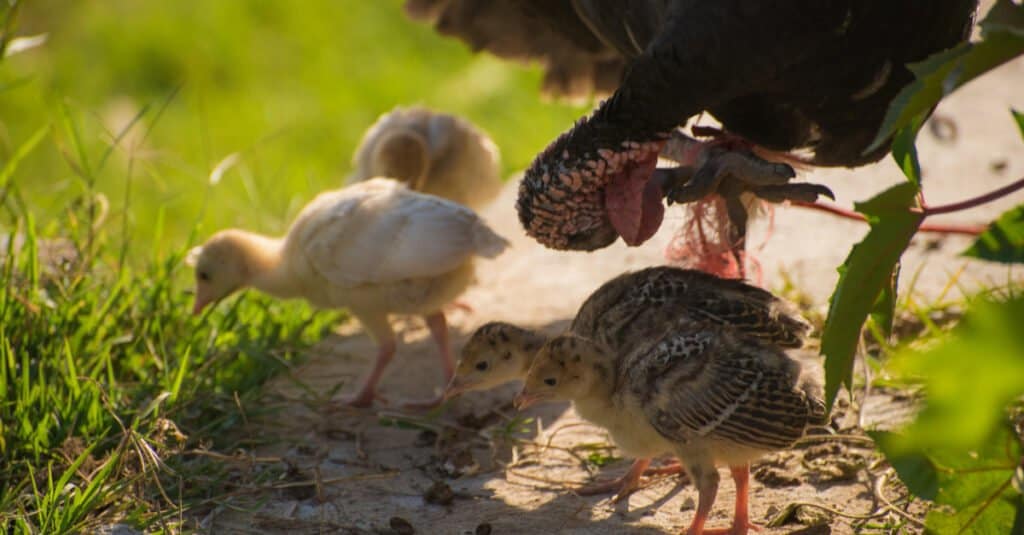Baby turkeys are astounding creatures who love the warmth. But did you know that they are extraordinarily social or that they have many different sounds? Check out these and more facts about baby turkeys!
#1: A Baby Turkeys are Called Poults or Chicks!

Baby turkeys are called chicks, and sometime poults!
©Ariusz Nawrocki/Shutterstock.com
A baby turkey is called a poult. They’re also sometimes called chicks as well. Turkey chicks share their title with other birds like pigeons and chickens. When a chick grows up, it will be called a tom or gobbler if it is male and a hen if it is female! A group of turkeys is called a rafter.
#2: Turkey Chicks are Super Social

Turkey chicks love to make friends.
©iStock.com/vfhnb12
When you think of social animals, what comes to mind? Cats, dogs? Even though turkeys might not be the first animals you think of, they are extremely social creatures. In fact, they are often called the most social of all birds.
Baby turkeys love to make new friends in their flocks. They can often be seen playing and being affectionate with other turkeys. Scientists say that chicks can even form lasting bonds with other animals in their group. For context, they are about as social as a dog.
Like chickens, turkey babies are also very friendly toward people. They are extraordinarily intelligent animals with trust for their owners. So much so, that some people even keep turkeys as pets! Male turkeys are known for their beautiful feathers, while females are desired for their ability to lay eggs. Turkeys are so smart that they can memorize the details of over 1,0000 acres of land.
#3: Turkey Chicks Have a Unique Voice

Turkey poults can make more than 20 different sounds!
©Waidelotte/Shutterstock.com
Did you know that “gobble” isn’t the only sound a turkey makes? Even though this is the most commonly known turkey sound, they can actually make over 20 different noises. In fact, only adult male turkeys can gobble – who knew!
When baby turkeys are lost or need help from their parents, they let out a high-pitched yelp. When adult turkeys yelp, it often means they are looking for a mate. It can also be used as a way for turkeys to tell others where they are.
Another sound that turkey poults make sounds like “kee-kee”. They usually make this sound when they get separated from their flock. It is most commonly used when hunters intentionally separate a flock to make it easier to score their Thanksgiving meal.
#4: Baby Turkeys are Irrecognizable as Turkeys at Birth!

Newborn turkeys don’t look very much like their parents at first.
©Gansstock/Shutterstock.com
Turkeys are pretty noticeable animals. With large bodies and decorative tails that fan out similarly to a peacock, they’re not difficult to spot. Male turkeys have vibrant feathers in many colors like red, green, and copper. Females have dull brown fur.
However, if you saw a newborn baby turkey, you might not realize it was a turkey at all! Turkey chicks are born with a light layer of downy feathers. This layer is called a “preen”. Though adult turkeys will grow to be up to 24 pounds, baby turkeys are of course, much smaller.
The smallest turkey baby, called the Royal Palm turkey, usually weighs under a pound. Larger varieties can weigh up to four pounds as newborns. These tiny birds look more like chickens than turkeys as newborns since their tails are very short.
Male turkey chicks have a fleshy flap of skin called a snood. The snood changes color based on the turkey’s mood. Their head also changes color along with the snood. When the turkey’s head is blue, it indicates that he is excited. When he is angry, his snood and head will turn red.
#5: Turkey Chicks Love Heat

Turkey chicks prefer a warm environment.
©Arturo Verea/Shutterstock.com
Since turkeys are birds, you probably already knew that they hatch from eggs. While turkeys grow inside their eggs, they need a constant source of heat to protect them. Usually, mother turkeys sit on their eggs in a process called roosting to keep them warm until they’re ready to hatch.
But did you know that baby turkeys still love warmth even after they’re done hatching? It’s true! Being in a warm environment helps baby turkeys regulate their body temperature. It also helps them to be able to pass bowel movements easily.
When turkeys are kept in captivity, owners use a special enclosure called a brooder to keep them warm. A heat lamp is used to control the temperature.
The photo featured at the top of this post is © Gansstock/Shutterstock.com
FAQs (Frequently Asked Questions)
What is a baby turkey called?
A baby turkey is called a chick out a poult! Baby turkeys are only considered “babies” for about the first four or five weeks. After that, a young male turkey is called a Jake and a young female is called a Jenny.
How much do baby turkeys weigh?
The size of newborn turkeys depends on their breed. The smallest newborn turkeys weigh just under a pound and the largest can weigh four or more pounds at birth.
What do baby turkeys eat?
Baby turkeys enjoy a diet of small insects, berries, and even seeds!
Where do baby turkeys live?
Turkeys are native to the United States. They are also found throughout Canada.
Thank you for reading! Have some feedback for us? Contact the AZ Animals editorial team.






